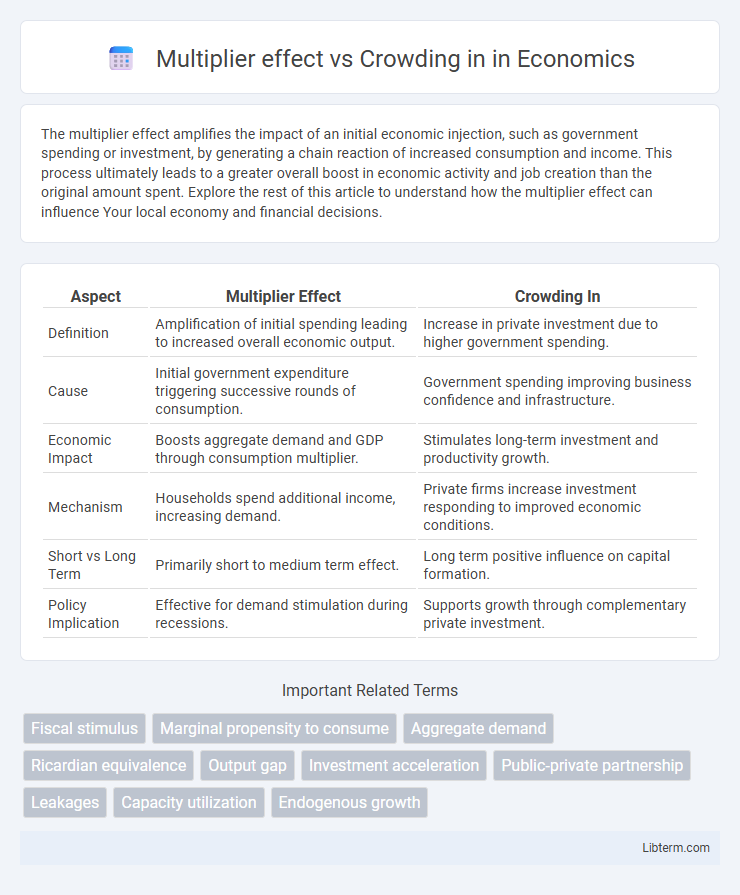The multiplier effect amplifies the impact of an initial economic injection, such as government spending or investment, by generating a chain reaction of increased consumption and income. This process ultimately leads to a greater overall boost in economic activity and job creation than the original amount spent. Explore the rest of this article to understand how the multiplier effect can influence Your local economy and financial decisions.
Table of Comparison
| Aspect | Multiplier Effect | Crowding In |
|---|---|---|
| Definition | Amplification of initial spending leading to increased overall economic output. | Increase in private investment due to higher government spending. |
| Cause | Initial government expenditure triggering successive rounds of consumption. | Government spending improving business confidence and infrastructure. |
| Economic Impact | Boosts aggregate demand and GDP through consumption multiplier. | Stimulates long-term investment and productivity growth. |
| Mechanism | Households spend additional income, increasing demand. | Private firms increase investment responding to improved economic conditions. |
| Short vs Long Term | Primarily short to medium term effect. | Long term positive influence on capital formation. |
| Policy Implication | Effective for demand stimulation during recessions. | Supports growth through complementary private investment. |
Introduction to Multiplier Effect and Crowding In
The multiplier effect describes how an initial increase in investment leads to a greater overall increase in national income, as subsequent rounds of spending stimulate further economic activity. Crowding in occurs when increased government investment encourages additional private sector investment, amplifying the multiplier effect by boosting investor confidence and economic prospects. Both concepts highlight mechanisms through which fiscal policy can spur broader economic growth beyond the initial expenditure.
Defining the Multiplier Effect
The multiplier effect describes how an initial increase in spending leads to a greater overall rise in national income, as each round of expenditure generates additional consumption and investment. This economic concept quantifies how fiscal stimulus or investment can expand aggregate demand beyond the original amount injected into the economy. Understanding the multiplier effect is crucial for analyzing fiscal policy impacts and contrasting them with crowding-in, where government spending encourages private sector investment.
Understanding Crowding In
Crowding in refers to the phenomenon where increased government spending leads to a rise in private sector investment by boosting overall economic demand and improving business confidence. This effect contrasts with the crowding out theory, which suggests government borrowing raises interest rates, thereby reducing private investment. Understanding crowding in is essential for assessing fiscal policies that aim to stimulate economic growth through complementary public and private sector collaboration.
Key Differences Between Multiplier Effect and Crowding In
The multiplier effect amplifies initial government spending, generating increased total economic output through successive rounds of consumption and investment. Crowding in occurs when government expenditure stimulates private sector investment by boosting demand or improving economic conditions. Key differences include the multiplier effect's focus on overall output expansion, while crowding in specifically highlights enhanced private investment responses.
Economic Theories Behind the Multiplier Effect
The multiplier effect in economics describes how an initial increase in spending leads to a larger overall increase in national income, driven by successive rounds of consumption and investment. Crowding-in occurs when increased government expenditure stimulates private sector investment, enhancing economic growth rather than displacing private spending. The underlying economic theories highlight the relationship between fiscal stimulus and aggregate demand, showcasing how multiplier effects depend on factors like marginal propensity to consume and the responsiveness of private investment to public spending.
Mechanisms Driving Crowding In
Crowding in occurs when increased public sector investment stimulates additional private sector spending, driven by mechanisms such as enhanced infrastructure, reduced business uncertainty, and improved market confidence. Unlike the multiplier effect, which measures the overall economic impact of fiscal injections, crowding in specifically highlights positive spillovers that attract private capital and innovation. Key drivers include government spending on complementary goods, targeted research and development, and policies fostering public-private partnerships that lower transaction costs and encourage private investment.
Factors Influencing the Size of the Multiplier
The size of the multiplier effect is influenced by factors such as the marginal propensity to consume, the level of taxation, and the extent of imports, as higher consumption and lower leakages amplify the multiplier. Crowding-in occurs when increased government spending leads to higher private investment, often driven by improved business confidence and lower interest rates, enhancing the overall economic impact. Conversely, crowding-in can expand the multiplier effect, while crowding-out diminishes it by raising interest rates and reducing private sector spending.
Real-World Examples: Multiplier Effect vs Crowding In
The multiplier effect occurs when government spending generates increased economic activity, as seen in post-2008 stimulus packages that boosted employment and consumer demand. Crowding in happens when public investment encourages private sector investments, exemplified by infrastructure projects like Germany's Autobahn expansion attracting new businesses. Both phenomena demonstrate how fiscal policy can stimulate overall economic growth through different mechanisms.
Policy Implications for Fiscal Stimulus
Fiscal stimulus policies that leverage the multiplier effect can significantly boost economic output by increasing aggregate demand through government spending. However, crowding-in occurs when government expenditure stimulates private investment by improving economic conditions, enhancing the overall policy impact. Policymakers must balance these dynamics to maximize stimulus efficiency, ensuring that increased public spending does not deter private sector participation but rather fosters complementary investment growth.
Conclusion: Weighing the Economic Impact
The multiplier effect generates amplified economic growth by increasing aggregate demand through successive rounds of spending, whereas crowding in enhances private investment driven by greater public sector activity. Evaluating their economic impact requires understanding the context-specific balance where the multiplier boosts short-term output, while crowding in fosters long-term capital formation and productivity gains. Policymakers must consider fiscal conditions and market responses to optimize aggregate demand without dampening private sector investment growth.
Multiplier effect Infographic

 libterm.com
libterm.com